For citation, please use:
Yuneman, R.A., 2023. Kazakhstan’s Multi-Vector Foreign Policy. Russia in Global Affairs, 21(2), pp. 141–162. DOI: 10.31278/1810-6374-2023-21-2-141-162
The Republic of Kazakhstan appeared as an independent state in 1991. The foundations of its foreign policy were laid by Nursultan Nazarbayev in May 1992 in his policy article titled “Strategy for the Formation and Development of Kazakhstan as a Sovereign State.” It proclaimed the security of the new Kazakhstan as the main goal of its foreign policy. Security was to be ensured, among other things, by a strategic partnership with neighbors—Russia and China—as well as close cooperation with Central Asian states, Turkey, Pakistan, and India (Nazarbaev, 1992). This foreign policy imperative, implying an orientation to several centers of power, was later called a multi-vector approach.
But Kazakhstan’s request for help from the CSTO to resolve an internal crisis and the start of Russia’s special military operation in Ukraine raise questions about the future of the country’s multi-vector foreign policy. It is all the more important, therefore, to understand how this policy has been implemented until now.
Despite Kazakhstan’s de facto adherence to a multi-vector policy throughout its existence, for the first time it was officially designated as a concept in 2007 in a presidential address to the nation (Poslanie, 2007). From then on, a multi-vector approach would be described as the main principle of Kazakhstan’s Foreign Policy Concepts adopted in 2014 and 2020 (Kontseptiya, 2014, O Kontseptii, 2020). This foreign policy is defined in official doctrines as “a diplomatic strategy based on building relations with the international community in general and with the neighboring states in particular on a pragmatic and balanced basis” (O Kontseptsii, 2020). This definition of a multi-vector policy makes it synonymous with the foreign policy of the state as a whole (in a neorealist context).


For example, Armenia called it “complementarianism,” Uzbekistan under Islam Karimov also declared commitment to a multi-vector foreign policy (Minasyan, 2012, p. 268; Nomerovchenko, Kim and Kang, 2018, p. 401). Official Minsk understands a multi-vector policy as the willingness of the state to cooperate “with everybody,” that is, with several, often conflicting, centers of power in a particular region (Shadursky, 2010, p. 50).
According to Reuel Hanks, a multi-vector foreign policy is a policy that builds relations with other countries on a pragmatic rather than ideological basis (Hanks, 2009, p. 259). Researcher Elena Gnedina argues that the essence of a multi-vector policy is that “‘multi-vector’ states neither balance nor bandwagon”[1]—the post-Soviet elites bargain with competing external actors over the terms of cooperation. As their bargaining power is evidently circumscribed, the post-Soviet states try to increase bargaining power by means of tactical maneuvering while pursuing their own objectives. The latter include wealth—and power—maximization, as well as maintaining a degree of autonomy from both external actors in order to prolong the bargaining game (Gnedina, 2015, p. 1009).
This approach raises the question of similarity between a multi-vector policy and a policy of hedging which ensures security and maximizes economic benefits. “Based on the above defining parameters, hedging is conceived as a multiple-component strategy between the two ends of the balancing-bandwagoning spectrum” (Kuik, 2008, p. 165).
Although political maneuvering between major players is characteristic of small and middle powers in different regions of the world, the term ‘multi-vector’ is applied mainly to post-Soviet countries. States may pursue a multi-vector policy for different reasons, both exogenous and endogenous. For example, one of the reasons why Kazakhstan adopted a multi-vector foreign policy (apart from the obvious one such as the presence of major external actors in the region, whose interests do not always coincide) may be the need to legitimize statehood both in the eyes of Russians and Kazakhs (Cummings, 2003, p. 150). Nevertheless, a multi-vector policy is a way for all post-Soviet states to assert their own sovereignty vis-a-vis Russia since it implies stronger economic and political ties with other centers of power, which, in turn, reduces Russia’s possibility to influence the country’s foreign and domestic policy.
Kazakhstan’s multi-vector foreign policy concept has been studied relatively well, including its causes and evolution (Kassen, 2018; Bastas, 2013), practical application for balancing between China and Russia (Diyarbakirlioğlu and Yiğit, 2014), and its implementation in the economic and energy sectors (Nurgaliyeva, 2016). Separately, we can mention works by Charles Sullivan and Michael Clarke, who determine a multi-vector policy primarily as a policy of protecting independent Kazakhstan from Russia’s dominance, and note the unclear future of this policy due to the ongoing confrontation between Russia and the West (Sullivan, 2019).


However, Kazakhstan’s multi-vector policy in respect to major international issues remains unexplored. It seems important to determine the degree of congruence[2] of Kazakhstan’s foreign policy with that of key external players in Central Asia. This is why the manifestation of a multi-vector policy in relations with the four abovementioned countries on major international issues is the subject of this article.
To determine the degree of such congruence, we can analyze the results of voting in the UN General Assembly (UNGA). One of the modern researchers of voting patterns in the UNGA, Erik Voeten, notes that such an analysis can show the degree to which countries share common foreign policy interests or preferences (Voeten, 2013, p. 13). For example, based on a quantitative analysis of voting in the UNGA, Russian researcher David Khachaturyan concludes that there is a correlation between the type of relations (“allied” or “privileged”) and voting cohesion in the UNGA between Armenia and Russia/France (Khachaturyan, 2017).
Researchers also study voting patterns characteristic of countries participating in various unions in order to find out whether these countries pursue a coordinated foreign policy (Lijphart, 1963, pp. 902-917). Moreover, the results of voting on UNGA resolutions also indicate how similar the foreign policy of countries within one bloc can be to that of major international actors. For example, an analysis of the voting by ASEAN countries, Japan, China, and the United States indicates that the bloc’s foreign policy is closer to that of China rather than to Japan’s or the United States’ (Burmester and Jankowski, 2014).
Most of the works analyzing Kazakhstan’s voting in the UNGA consider the republic in the context of Central Asia or the CIS as a region. For example, the foreign policy closeness of Kazakhstan and other CIS states is assessed by analyzing voting cohesion in the UNGA (Kurylev et al., 2018; Degterev et al., 2018; Hansen, 2015). In his work “May We Have a Say? The Central Asian States in the UN General Assembly,” Filippo Costa Buranelli (2014) examines the results of voting by Kazakhstan through the lens of foreign policy coordination with other Central Asian countries and Russia, concluding that the positions of Central Asian states are more coordinated among themselves than with Russia..
Gleb Kozlov’s study (2020) that analyzes the voting by Kazakhstan and the United States on UNGA resolutions is worth noting separately as one of the few works exploring the concurrence of positions between Kazakhstan and a major international actor. In his work, the author quantifies the results of voting by Kazakhstan and the United States on UNGA resolutions and concludes that there is a significant disagreement between their positions (and greater similarity of positions between Kazakhstan and Russia) (Kozlov, 2020, p. 584).
However, voting cohesion of Kazakhstan and China, and Kazakhstan and Germany (as one of the EU countries that are most active in Central Asia) has not been studied so far. The voting patterns of Kazakhstan and Russia have been studied only in general terms. Moreover, in order to better understand Kazakhstan’s multi-vector policy, it is necessary to conduct a comprehensive analysis of voting in the UNGA by Kazakhstan and other key players in the region: Russia, the EU, the U.S., and China.
Studying voting cohesion in the UNGA also seems important in light of the fact that Kazakhstan and Russia formally pursue a “coordinated foreign policy” as stated in Article 4 of the Treaty between the Russian Federation and the Republic of Kazakhstan on Good-Neighborliness and Allied Relations in the 21st Century (Dogovor, 2013), although Kazakhstan has no agreement on such “coordinated foreign policy” with other countries in question.


Therefore, we will study cases of convergence and divergence in voting on UNGA resolutions by Kazakhstan and the other four countries: Russia, the U.S., China, and Germany. In so doing, we will analyze only those resolutions that were put to the vote in the UN General Assembly from 2007 to 2022 (a total of 1,236 resolutions voted on from the 63rd to the 76th sessions). The year 2007 was selected because that is when the term ‘multi-vector policy’ was introduced into official discourse, Eurasian integration was relaunched, and an agreement on the creation of the Customs Union was signed. The year 2022 was chosen because it will allow us to study the result of UNGA voting concerning Russia’s special military operation in Ukraine. Within the selected time frame, the periods of 2007-2013 and 2014-2022 will be considered separately in order to see how Kazakhstan’s voting changed before and after the beginning of active confrontation between Russia and the West. It seems interesting to find out if there were any changes in Kazakhstan’s voting pattern after the reincorporation of Crimea into Russia, as increasingly antagonistic relations between Russia and the United States/Germany could result in lesser support for Russia’s position in the UNGA.
All voting data for analysis were borrowed from the United Nations Digital Library System. A strict approach to analysis was applied: only completely identical voting results were counted (four possible options: “yes,” “no,” “abstention,” and “non-voting”). They were then divided by the number of resolutions per period and multiplied by 100%. Any difference in voting was considered a divergence. The resulting figure represents the identical voting ratio for the two countries. In case of conflicting voting, only those of them were counted where the two countries voted antagonistically (only “yes” and “no” were taken into account).
Analysis of Voting on UNGA Resolutions
Table 1 below shows the results of the analysis of the voting by Kazakhstan, Russia, the U.S., China, and Germany to determine identical positions in 2007-2013, specifying the number of resolutions put to the vote, as well as their key topics.
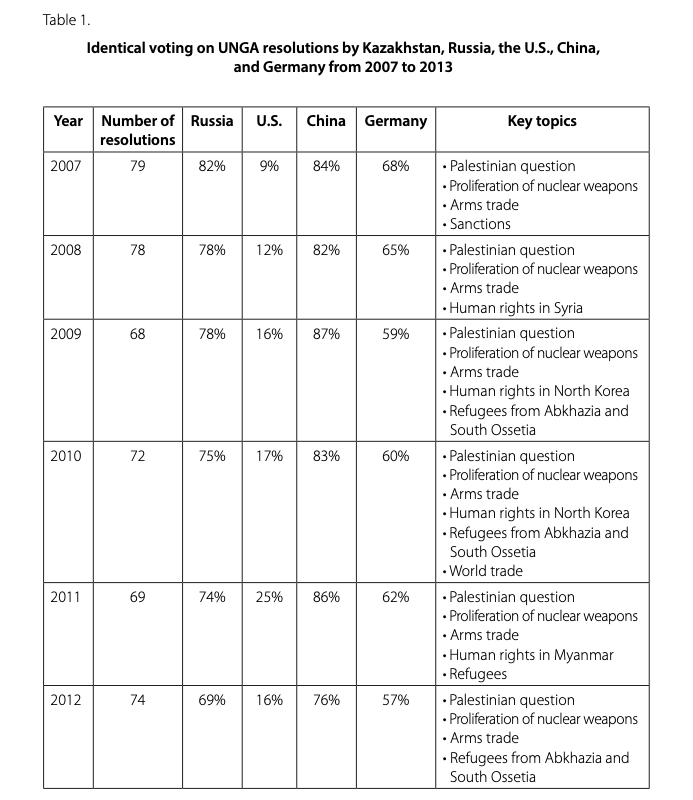

Several conclusions can be drawn from this table:
- The share of identical voting by Kazakhstan and Russia is quite high and ranges from 64% to 82%, but decreases significantly throughout the entire period under review.
- Although Russia is officially viewed as a key foreign policy partner and the two countries vow to conduct a “coordinated foreign policy,” Kazakhstan’s voting is often identical to that of China (from 76% to 89%), and the share of such voting does not decrease during the stated period.
- Kazakhstan votes more often identically to Germany (from 55% to 68%) and in the vast majority of cases it votes differently from the United States—the share of matching votes varies from 9% to 25%.
In general, this voting pattern reflects the greater role of Russia and China in Kazakhstan’s foreign policy than of the United States or Germany. Nevertheless, a large number of cases when Kazakhstan’s position matched China’s, rather than Russia’s, is quite surprising. Kazakhstan, in fact, balances against Russia with the help of China, but this balancing occurs primarily in the economic sector (Nurgaliyeva, 2016, p. 93). At the same time, Kazakhstan and Russia are members of a typical asymmetric military-political alliance (CSTO), where symbolic gestures on the part of a smaller power in support of a larger power’s foreign policy are usually quite important (Istomin and Baikov, 2019, p. 39).
If we consider only those cases where Russia and one of the other three countries voted oppositely (for example, “for” and “against” a certain resolution), then we can draw up the following table.

Table 2 indicates that in the vast majority of cases when Russia and the United States voted oppositely, Kazakhstan supported Russia. In similar situations with Germany, this happened in two-thirds of cases. Nevertheless, in the Russia-China duo, Kazakhstan sided with Russia in 31% of instances (and yet, the number of such cases is not big enough to draw unambiguous conclusions).
As for specific resolutions, we should consider those situations in which Kazakhstan supported or did not support Russia’s position when it differed from that of China, the U.S. or Germany.
Although in the vast majority of cases Kazakhstan backed Russia when the United States voted differently, Kazakhstan sided with the U.S. on Syria resolutions in 2011 and 2012 (Resolutions 66/176 and 67/183), even though Russia voted against them. In addition, in 2007-2013, Kazakhstan supported resolutions concerning human rights in North Korea and Myanmar (for example, Resolutions 64/238 and 65/225).
In some cases when Russia and the United States voted oppositely, Kazakhstan abstained from voting, particularly on resolutions, initiated by Western countries, on refugees from Abkhazia and South Ossetia (64/296, 66/283, etc.) and, since 2013, on resolutions concerning the Syria conflict. It is worth noting that as soon as the Syrian issue became important for both Russia and the United States, Kazakhstan changed its voting tactics from “yea” to “abstained.”


When Russia and Germany voted oppositely, Kazakhstan did not back Russia in a third of such cases. In addition to the abovementioned resolutions on the conflicts in Georgia and Syria (in which Germany and the United States often voted identically), Kazakhstan supported resolutions on the non-proliferation of nuclear weapons (67/55, 68/39, etc.).
When Russia and China voted oppositely on the same issue, Kazakhstan more often sided with China (a total of 13 cases), including on nuclear disarmament (67/46, etc.), and with Russia on the abolition of death penalty (65/206, etc.).
It is worth noting that in 2007-2013, Kazakhstan voted more than twenty times differently from Russia, China, the U.S., and Germany, mainly on the issue of nuclear security. Kazakhstan supported resolutions aimed at limiting the proliferation and use of nuclear weapons, such as 65/60, 66/48, 67/45 and others. This is consistent with Kazakhstan’s commitment to universal nuclear disarmament since regaining independence (Shaukenova, 2020). This positioning is important for Kazakhstan as it helps, among other things, to symbolically reaffirm its own sovereignty as a relatively young state.
In general, it can be concluded that during this period Kazakhstan voted more often similarly to China than to the other three countries. At the same time, the percentage of matching votes with Russia and Germany decreased by 18% and 13%, respectively, with an approximately equally low level of identical votes with the United States. In addition, Kazakhstan abstained from voting on the conflict in Abkhazia and South Ossetia, which is a key issue for Russia, and voted contrary to Russia on disarmament and human rights in North Korea and Myanmar.
Based on the results of the voting in the UNGA from 2014 to 2021, we can say that throughout that period, Kazakhstan voting in about 62-69% of cases was in accord with Russia. At the same time, the share of Kazakhstan’s matching voting with China remained bigger than that with Russia—74-82%. Otherwise, the share of identical voting with Germany decreased from 59 to 50%.[3]
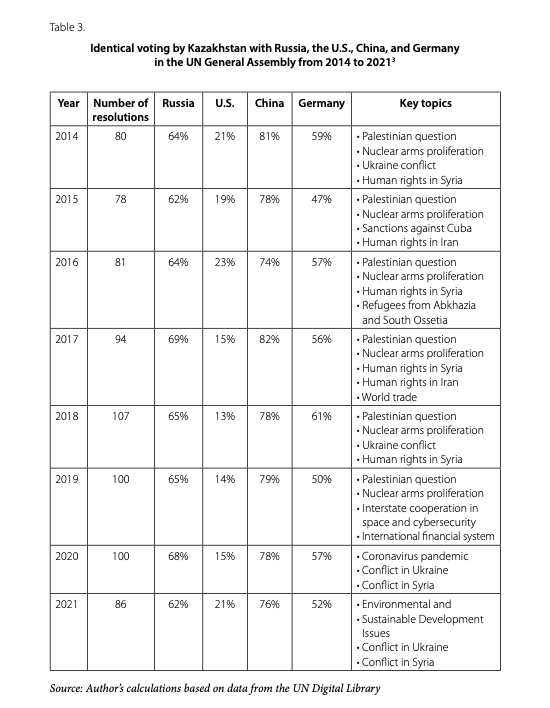
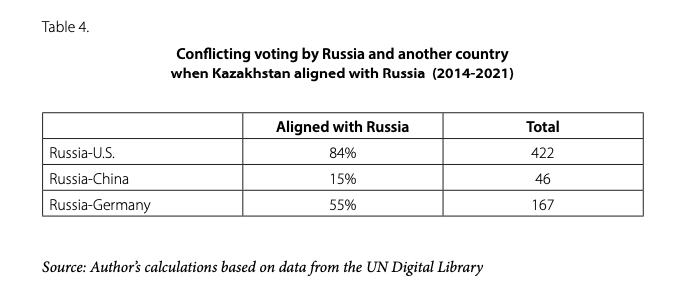
Speaking of the voting where Russia’s position was directly opposite to the position of the United States, China or Germany, the following can be said:
- In the overwhelming majority of cases when Russia and the United States voted differently, Kazakhstan continued to vote in concert with Russia;
- In half of the conflicting voting cases between Russia and Germany, Kazakhstan voted along with Russia;
- Only in 15% of cases in 2014-2021, Kazakhstan voted identically with Russia and contrary to China’s position;
- Also, compared to the previous period, the cases when Kazakhstan aligned with Russia during conflicting voting decreased significantly compared to the three other countries: by 7% in the case of the United States, by 12% in the case of Germany, and by 16% in the case of China. At the same time, the total number of conflicting voting cases increased in all three categories.
While voting on UNGA resolutions, when the United States and Russia held the opposite positions, in 16% of cases, Kazakhstan voted differently from Russia. Like in the previous period, this concerned resolutions on human rights in North Korea and Myanmar (69/188, 73/64, etc.) and resolutions on non-proliferation of chemical and nuclear weapons (72/43, 74/50, etc.). Also, Kazakhstan abstained from voting on more than thirty resolutions over the same period if the positions of the United States and Russia differed, particularly on the situation in South Ossetia and Abkhazia, on the militarization of Crimea (74/17), and on the withdrawal of troops from Moldova (72-282). In addition, Kazakhstan abstained from voting on Resolution 68/262 “Territorial Integrity of Ukraine.”
It is worth noting separately that since 2013 Kazakhstan abstained from voting on all UN resolutions concerning the conflict in Syria (for example, 73/182, 71/130 and 68/182), which were opposed by China and Russia, but supported by the United States and Germany. These examples once again indicate that Kazakhstan resorts to the policy of hedging when several centers of power confront each other, and holds a neutral position (in particular, on the Syrian issue).
After the start of Russia’s special military operation in Ukraine, Kazakhstan abstained from voting on key UNGA resolutions, thus continuing its hedging tactics with regard to voting on controversial resolutions (ES-11/1, ES-11/2). Nevertheless, Kazakhstan voted against the UNGA resolution to exclude Russia from the Human Rights Council, fully supporting the Russian Federation (ES-11/3). This might have been prompted by the need to compensate for harsh statements made by the Kazakh presidential administration chief of staff that Astana was not eager to help Moscow circumvent Western sanctions.
In the cases where Russia and Germany voted oppositely (in addition to those considered above with regard to voting by the U.S.), Kazakhstan voted in accord Germany on the following issues: countering the proliferation of cluster munitions (74/62, etc.), non-proliferation of nuclear weapons (71/51, etc.) and environmental protection (72/277).
In 2014-2019, the number of cases of conflicting voting by China and Russia increased to forty-six, with Kazakhstan voting in accord with China more often. Kazakhstan sided with Russia on death penalty (71/187, etc.) and decolonization (70/231), and supported China on non-proliferation of nuclear weapons (73/60, 74/45, etc.) and environmental protection (72/277).
Several factors could influence Kazakhstan’s voting. Firstly, the nuclear disarmament agenda is a key one for Kazakhstan, which votes consistently every year for all resolutions addressing this issue. Secondly, during the period under review, there was not a single case of direct conflict between Russia and China in the UNGA, which could have forced Kazakhstan to choose between the two.
In this context, what is interesting is not just Kazakhstan’s position when Russia and China vote differently, but the very situation in which Kazakhstan votes in many ways identically to China rather than Russia. Given a treaty of allied relations between Kazakhstan and Russia, and a collective security treaty (Kazakhstan has neither with China), such coincidence seems unusual. But it is hard to understand what actually stands behind it: whether it is identical foreign policy agendas of the two countries or an attempt to counterbalance Russia at least in such a way.


In 2014-2021, Kazakhstan voted differently from the other countries in question more than sixty times, including thirty-four resolutions concerning nuclear non-proliferation and nuclear disarmament (for example, 74/41, 73/57, 72/41 and others). Kazakhstan supported these resolutions, while China, Germany, the U.S., and Russia either abstained from voting or voted against them. In general, it can be concluded that during this period Kazakhstan did not change its position and continued to advance the nuclear disarmament agenda, despite possible disagreements with major players in Central Asia.
In general, Kazakhstan continued the policy of 2007-2013, refusing to provide direct support to Russia on the conflicts in Georgia and Ukraine and upholding all resolutions concerning disarmament and nuclear non-proliferation. Although the overall pattern of Kazakhstan’s voting on UNGA resolutions did not change after 2014, the number of cases of identical voting with Russia continued to decrease, especially when Russia’s position disagreed with that of China, Germany, or the United States.
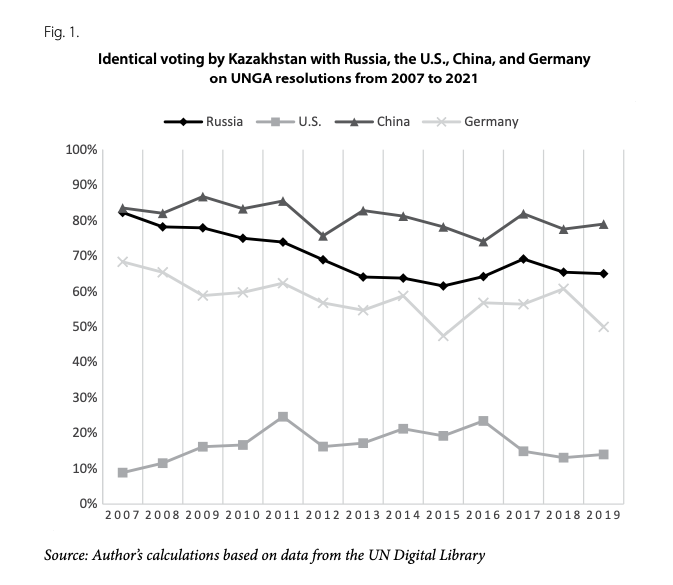
The chart above shows that Kazakhstan most often voted in UNGA resolutiins identically with Russia and China, which remained Kazakhstan’s key partners in the region during the period under review. The chart also shows that over this period Kazakhstan voted less and less often identically with Russia and Germany, and its voting matched that of the U.S. just about as often as before. The position of Russia changed significantly: while at the beginning of the period under review it shared first place with China in terms of voting cohesion, at the end it came close to contending Germany for second place.
The degree of voting coherence between Kazakhstan and other powers differed depending on the subject of a resolution. Thus, Kazakhstan’s voting in the UNGA agreed with Russia’s by 80% or more on resolutions concerning human rights, global development issues, the Palestinian conflict, and decolonization, matching by 92-97% in the latter case (see Fig. 2 and Fig. 3). In addition, the degree of identical voting on these issues by Kazakhstan and Russia practically did not differ in 2007-2013 and 2014-2022. At the same time, the positions of Russia and Kazakhstan on disarmament resolutions coincided on average in 60% of cases in both periods. The level of voting cohesion dropped significantly with regard to resolutions concerning armed conflicts (from 61% to 46%) and nuclear disarmament (from 51% to 20%).
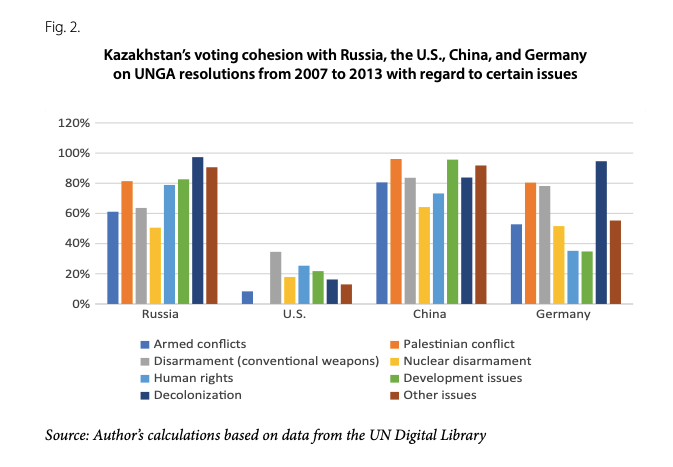
Kazakhstan’s and China’s positions coincided almost completely on the Palestinian conflict (96-98% of resolutions), and disarmament (over 84-85%). On all other issues, the positions of Kazakhstan and China coincided at least 55% of the time. At the same time, compared to the previous period, the number of instances when the two countries voted identically on such issues as development, decolonization, and armed conflicts decreased in 2014-2022 by 11-13%. It is also noteworthy that Kazakhstan’s position matched that of China on resolutions concerning armed conflicts and nuclear disarmament more often than the position of Russia or Germany.
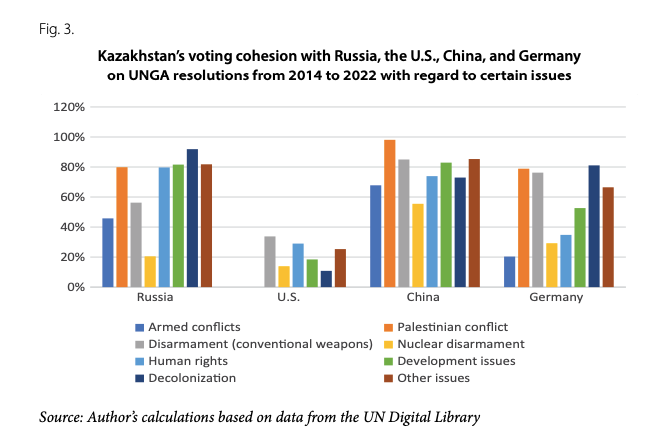
Kazakhstan and Germany have identical positions (in more than 77% of instances) on resolutions concerning the Palestinian conflict, disarmament, and decolonization. This number is 30-50% for resolutions concerning development issues, nuclear disarmament, and human rights. Separately, it is worth noting a decrease in the level of identical voting on nuclear disarmament and armed conflicts by 22% and 32%, respectively. At the same time, identical voting on development issues increased by 18% (the largest increase over the period under consideration). The level of identical voting by Kazakhstan and the United States remained low, ranging from 0% on the Palestinian issue to 35% on disarmament, in all periods under consideration.
As far as certain groups of resolutions are concerned, Kazakhstan’s position in most cases matched that of China (resolutions concerning armed conflicts, including the Palestinian one, and disarmament, including nuclear, as well as global development issues) and Russia (decolonization and human rights).


* * *
Kazakhstan pursues a multi-vector foreign policy in many ways, including through voting in the UN General Assembly. On the one hand, we can talk about a multi-vector policy in the UNGA where Kazakhstan abstained from voting on resolutions concerning Ukraine and Syria, which were important for both Russia, and the United States and Germany. On the other hand, the degree of voting cohesion between Kazakhstan and China is a vivid manifestation of a multi-vector approach, although it is Russia that is Kazakhstan’s key ally in the region.
As far as key extra-regional players are concerned, there is a clear hierarchy of vectors, at least on major international issues. The key vector is not a CSTO partner—Russia—but China. The level of voting cohesion between Kazakhstan and China in the UNGA is much higher than with Russia or Germany, let alone the U.S. This is also true of voting on certain groups of international issues. The greatest coincidence of positions is observed between Kazakhstan and China on resolutions concerning armed conflicts, disarmament, and global development issues. At the same time, Kazakhstan’s position is the closest to Russia’s on human rights and decolonization.
Despite the stated “coordinated foreign policy” of Kazakhstan and Russia, the level of voting cohesion between the two countries in the UNGA decreased in 2014-2022, firmly staying below that between Kazakhstan and China. Moreover, in situations where Russia and China voted differently on the same issues, Kazakhstan overwhelmingly voted in concert with China. And although Kazakhstan considerably more often sided with Russia when the latter voted contrary to the U.S., it supported Russia’s position a little more than half of the time when Russia and Germany opposed each other (from 2013 to 2022).


Determining the exact reasons for such voting cohesion with China is beyond the scope of this article. Yet presumably, the reason may lie in that Kazakhstan’s foreign policy agenda is identical to that of China, or in the absence of direct conflict between China and Russia, which would otherwise force Kazakhstan to make a difficult choice. Nevertheless, such a voting pattern displayed by the two countries, which are members of the same military-political alliance, requires further research into the nature of allied relations between Russia and Kazakhstan.
In the context of Kazakhstan’s foreign policy doctrine, a multi-vector approach means a pragmatic foreign policy towards all key states. Nevertheless, this definition is too vague and can mean both “pragmatic balancing” and “pragmatic bandwagoning.” As far as the implementation of foreign policy is concerned, we can observe the use of multidirectional political strategies. On the one hand, Kazakhstan is in a defensive alliance with Russia, which has proven quite effective during domestic political crises. On the other hand, Kazakhstan abstained from voting on most resolutions that are crucial for Russia and concern armed conflicts (Syria, Abkhazia and South Ossetia, Crimea). At the same time, Kazakhstan also abstained from voting even when both Russia and China voted against, which indicates a more complex relationship between Kazakhstan and major powers than simple balancing along the Russia-China axis. Kazakhstan bandwagons Russia in terms of security, but at the same time purses a policy of balancing on political issues, maintaining neutrality. Such foreign-policy behavior fits the definition of hedging as a combined strategy that uses both balancing and bandwagoning to ensure security and maximize benefits. All of the above allows a definition of multi-vector policy as a special type of hedging specific to the post-Soviet space.
The specificity of Kazakhstan’ muti-vector policy is characteristic of the entire reviewed period. The increased confrontation between the West and Russia after the incorporation of Crimea in 2014, apparently did not affect the pattern of Kazakhstan’s voting in the UNGA.
It is worth noting that although the above analysis of voting on UNGA resolutions cannot provide a complete picture of relations between Kazakhstan and the great powers, it can definitely prod post-Soviet researchers into reassessing Russian-Kazakh and Sino-Kazakh relations. The reasons for Kazakhstan’s voting tactics in the UNGA, both internal and external, deserve a separate study.
With ongoing political changes in Central Asia, China’s growing influence, and a declining U.S. presence, Kazakhstan’s multi-vector policy may undergo significant changes. It may eventually alter, bringing the country closer to one of the centers of power, or, on the contrary, it may provoke a conflict between two or more actors in the region. One way or another, Kazakhstan’s multi-vector policy may change considerably in the coming years as Russia gains a new position in the world due to its special military operation in Ukraine.
Bastas, Y.N., 2013. The Foreign Policy of Kazakhstan: An Analysis of Kazakhstan’s Multi-Vector Policy. Master Thesis in Political Science Faculty of Social Sciences. Reprosentralen: Universitetet i Oslo Department of Political Science.
Burmester, N. and Jankowski, M., 2014. The Unsolved Puzzle: Pacific Asia’s Voting Cohesion in the United Nations General Assembly—a Response to Peter Ferdinand. The British Journal of Politics and International Relations, 16(4), pp. 680-689.
Clarke, M., 2015. Kazakhstan’s Multi-vector Foreign Policy: Diminishing Returns in an Era of Great Power “Pivots”? The Asian Forum, 9 April [online]. Available at: https://theasanforum.org/kazakhstans-multi-vector-foreign-policy-diminishing-returns-in-an-era-of-great-power-pivots/ [Accessed 5 December 2020].
Costa Buranelli, F., 2014. May We Have a Say? Central Asian States in the UN General Assembly. Journal of Eurasian Studies, 5(2), pp. 131-144.
Cummings, S.N., 2003. Eurasian Bridge or Murky Waters between East and West? Ideas, Identity and Output in Kazakhstan’s Foreign Policy. Journal of Communist Studies and Transition Politics, 19(3), pp. 139-155.
Degterev, D.A., Vasilyuk, I.P. and Baum, V.V., 2018. Parametry mnogovektornosti vneshnei politiki stran SNG: prikladnoi analiz [Multi-Vector Parameters of the CIS Foreign Policy: An Applied Analysis]. World Economy and International Relations, 62(1), pp. 63-75.
Diyarbakirlioğlu, K. and Yiğit, S., 2014. Kazakh Multi-Vector Foreign Policy in Action. Alternatives: Turkish Journal of International Relations, 13(4), pp. 70-82.
Dogovor, 2013. Dogovor mezhdu Rossiiskoi Federatsiei i Respublikoi Kazakhstan o dobrososedstve i soyuznichestve v XXI veke [Treaty between the Russian Federation and the Republic of Kazakhstan on Good Neighborliness and Cooperation in the 21st century]. Kremlin.ru, 11 November [online]. Available at: https://kremlin.ru/supplement/1560 [Accessed 5 December 2020].
Gnedina, E., 2015. ‘Multi-Vector’ Foreign Policies in Europe: Balancing, Bandwagoning or Bargaining? Europe-Asia Studies, 67(7), pp. 1007-1029.
Hanks, R.R., 2009. ‘Multi-Vector Politics’ and Kazakhstan’s Emerging Role as a Geo-Strategic Player in Central Asia. Journal of Balkan and Near Eastern Studies, 11(3), pp. 257-267.
Hansen, F.S., 2015. Do the CIS Member States Share Foreign Policy Preferences? Journal of Eurasian Studies, 6(1), pp. 69-78.
Istomin, I.A. and Baikov, A.A., 2019. Dinamika mezhdunarodnykh alyansov v neravnovesnoi mirovoi sisteme. Mirovaya ekonomika i mezhdunarodnye otnosheniya [Dynamics of International Alliances in an Unbalanced World Structure]. World Economy and International Relations, 63(1), pp. 34-48.
Kassen, M., 2018. Understanding Foreign Policy Strategies of Kazakhstan: A Case Study of the Landlocked and Transcontinental Country. Cambridge Review of International Affairs, 31(3-4), pp. 314-343.
Khachaturyan, D.A., 2017. Frantsiya, RF i SShA vo vneshnei politike Armenii: kolichestvenny analiz golosovaniya v GA OON [France, Russia and the USA in Foreign Policy of Armenia: Quantitative Analysis of Voting in the UN General Assembly]. RUDN Journal of Political Science, 19(1), pp. 91-100. DOI: 10.22363/2313-1438-2017-19-1-91-100.
Kontseptsiya, 2014. Kontseptsiya vneshnei politiki na 2014-2020 [Foreign Policy Concept for 2014–2020]. Informatsionno-pravovaya sistema normativnykh pravovykh aktov Respubliki Kazahstan [Legal-Informational Support System of Normative Legal Acts of the Republic of Kazakhstan] [online]. Available at: https://adilet.zan.kz/rus/docs/U1400000741/links [Accessed 2 December 2020].
Kozlov, G.V., 2020. Prikladnoi analiz golosovaniya Respubliki Kazakhstan i SShA v Generalnoi Assamblee OON (1992-2019 gg.) [Applied Analysis of the Voting of the Republic of Kazakhstan and the United States in the UN General Assembly]. Postsovetskie issledovaniya, 3(7), pp. 276-585.
Kuik, C., 2008. The Essence of Hedging: Malaysia and Singapore’s Response to a Rising China. Contemporary Southeast Asia: A Journal of International and Strategic Affairs, 30(2), pp. 159-185.
Kurylev, K., Degterev, D., Smolik, N. and Stanis, D., 2018. A Quantitative Analysis of Geopolitical Pluralism in the Post-Soviet Space. International Organisations Research Journal, 13(1), pp. 134-156.
Lijphart, A., 1963. The Analysis of Bloc Voting in the General Assembly: A Critique and a Proposal. American Political Science Review, 57(4), pp. 902-917.
Minasyan, S., 2012. Multi-Vectorism in the Foreign Policy of Post-Soviet Eurasian States. Demokratizatsiya, 20(3), pp. 268-273.
Nazarbaev, N.A., 1992. Strategiya stanovleniya i razvitiya Kazakhstana kak suverennogo gosudarstva (Alma-Ata, 1992 god) [Strategy of Formation and Development of Kazakhstan as a Sovereign State. Alma-Ata, 1992]. Informatsionnaya sistema PARAGRAF [online]. Available at: https://online.zakon.kz/Document/?doc_id=30006969 [Accessed 2 December 2020].
Nomerovchenko, A., Kim, J. and Kang, W., 2018. Foreign Policy Orientation of Independent Central Asian States: Looking Through the Prism of Ideas and Identities. The Korean Journal of International Studies, 16(3), pp. 389-410.
Nurgaliyeva, L., 2016. Kazakhstan’s Economic Soft Balancing Policy vis-à-vis Russia: From the Eurasian Union to the Economic Cooperation with Turkey. Journal of Eurasian Studies, 7(1), pp. 92-105.
O Kontseptsii, 2020. O Kontseptsii vneshnei politiki Respubliki Kazakhstan na 2020–2030 gody [On the Concept of Foreign Policy of the Republic of Kazakhstan for 2020–2030]. Akorda.kz [online]. Available at: https://www.akorda.kz/ru/legal_acts/decrees/o-koncepcii-vneshnei-politiki-respubliki-kazahstan-na-2020-2030-gody [Accessed: 02 December 2020].
Poslanie, 2007. Poslanie Prezidenta Respubliki Kazakhstan N. Nazarbayeva narodu Kazakhstana. 28 fevralya 2007 g. [Address of the President of the Republic of Kazakhstan N. Nazarbayev to the People of Kazakhstan. February 28, 2007]. Akorda.kz [online]. Available at: https://www.akorda.kz/ru/addresses/addresses_of_president/poslanie-prezidenta-respubliki-kazahstan-nnazarbaeva-narodu-kazahstana-28-fevralya-2007-g [Accessed 2 December 2020].
Shadursky, V.G., 2010. Realizatsiya printsipa mnogovektornosti v belorusskoi vneshnei politike [Realization of the Multi-Vector Principle in Belarusian Foreign Policy]. BGU, Trudy fakulteta mezhdunarodnykh otnosheniy 2010: nauchny sbornik, Vol. I.
Shaukenova Z. K., 2020. Put’ k bez’yadernomu miru. Initsiativy Elbasy [The Way to a Nuclear-Free World. The Elbasy Initiative]. KISI, August. Available at: https://www.kisi.kz/index.php/ru/biblioteka/publikatsii/25-shaukenova-zarema-kaukenovna/6373-put-k-bez-yadernomu-miru-initsiativy-elbasy [Accessed 2 December 2020].
Sullivan, C.J., 2019. End of an Era? Kazakhstan and the Fate of Multivectorism. In: Kazakhstan and the Soviet Legacy, pp. 31-50. Singapore: Palgrave Macmillan.
Voeten, E., 2013. Data and Analyses of Voting in the United Nations General Assembly. In: B. Reinalda (ed). Routledge Handbook of International Organization. Abingdon-on-Thames: Routledge.
Voting Data. United Nations Digital Library System. Available at: https://digitallibrary. un.org/search?ln=en&cc=Voting+Data [Accessed 5 December 2020].
[1] Balancing and bandwagoning are two key strategies of states in the international arena, implying attempts to minimize external threats from another state either through direct or indirect confrontation with this state by looking for external allies (balancing), or, conversely, through allied relations with the state posing such a threat (bandwagoning).
[2] In this context, foreign policy congruence means the “degree of concurrence,” which may not necessarily be due to mutual coordination or preliminary agreement between two countries.
[3] Hereinafter, six resolutions of the UNGA 76th Session, which were put to the vote in 2022, are considered voted on in 2021.










